Democratic Republic of Vietnam; November 1945/1946; Indochinese stamps with an overprint (Michel Nr. 1-12) After the United States dropped the atomic bombs on Hiroshima and Nagasaki on August 6th and 9th of 1945, Japan requested an armistice on August 15th. With all French troops being imprisoned or having fled, a power vacuum was created that was immediately used by Vietnamese Nationalists and the Viet Minh to take charge by seizing control of the major cities and all key administration centers in the country.[1] The Japanese, realizing that all was lost, offered no resistance and left the field pretty much to the Viet Minh and Nationalists to make it more difficult for the French to return to power. By August 19th, the Viet Minh had seized Hanoi and taken over the mail in all over the country. They of course found large quantities of Indochinese stamps in the post offices that had been used until then. In order to give voice to their desire for independence they started to overprint some of these issues in November of 1945 with “Viet Nam Dan Chu Cong Hoa” ( Democratic Republic of Vietnam), Doc Lap Tu Do Hanh Phuc Buu Chin (Independence Freedom Happiness Post Office)
The following stamp which was overprinted “Viet-Nam Democratic Republic Post Office” is shown by the Vietnamese Postage Stamp Catalogue forming part of the 1st overprint series, though Michel and other catalogue makers show the stamp as a standalone issue(Michel Nr. 1) that was released in 1946. Since the other overprint issues were also prepared in 1945/1946 the editor sees no reason as to why this stamp should not form part of this set.
Below is a pair that shows the two versions the overprint comes in. The left stamp has the 20mm wide overprint while the right stamp features the 18mm overprint. The base color of the original stamp is dark blue.
Here is a block of six stamps in a lighter blue color. All the left stamps carry the 20mm overprint while all the stamps on the right carry the 18mm overprint. Also note that the top right stamp of the block comes with an additional overprint variety. A red “half-moon” is imprinted left of the words “Cong-Hoa”. This variety occurs mostly in the top row of the sheet and probably stems from the mechanism that affixes the various overprint cliches in the sheet.
Society of Indochinese Philatelist member Mark Isaacs published the positioning the the two different types within a sheet of 50 stamps in the SICP Journal Nr. 75 (January/February of 1986) which shows that both types are equally represented.
Like all overprinted stamps in this series the 25c value is very rare used or on cover. Below are both overprint versions (left 20mm, right 18mm) cancelled. Two cancelled stamps are all the editor could manage to collect in over 25 years. The Michel catalogue value for a used stamp (regardless of the overprint version) is €120 and that is considered too low given the lack of availability. Only a handful of covers carrying this stamp have been found.
According to Michel there are double overprints on the 1c, 3c, 4c, 5c and 10c nominal but the catalogue maker values them very low. In over 25 years of collecting the editor could only find the 1c value below. So they are much rarer than what the catalogue would suggest.
There is common overprint error on the 2c, 4c and 10c. In this the words “Hanh Phuc” are upside down. The error appears to affect the entire overprinting but occurs only once per sheet (Field E8). Take a look at the bottom row of stamps. The error is pretty easy to spot. Since the error appears on all three nominals it is clear that the same plate was used for all overprintings.
Other overprint errors do occur, such as a slanted overprint on the 20c value and the “O” instead of “C and “M” instead of “H” error in the word “Chinh” . These are much rarer though.
Mint block of four of the 1C value which the overprint is moved upwards and on which the top two stamps show a distorted “H” of “HANH” that looks more like an “M”.


Mint block of four of the 1C value on which the top left stamp shows a plate error of “earring in C of PHUC” and the bottom stamps show the plate error of “II” instead of “III” lines in cap.

Detailed scans of the plate errors.
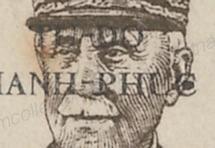
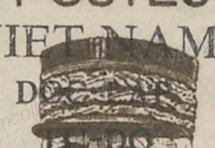

Cancelled to order 1C stamp with the overprint error “E in VIET broken at top left”.

Detailed scan of the affected area.

On field C3 one can find the overprint error “damaged D in DOC” on the 2C and 4C values.


Horizontal pair of the 3C overprinted stamp on which the right stamp show a missing “C” in “PHUC”.

Detailed scan of the affected area.

Cancelled to order pair of the 3C stamp on which the left stamp shows the plate error of “color partially covered”.

Detailed scan of the affected area.

on the 5C also a number of overprint errors have been noted. On field I3 one can find the error “B,C,H,N and H damaged in BUU CHINH”.

On field I4 one can find the error “U,C,H and N damaged in BUU CHINH”.

The 6C value has a number of overprint-errors. On field E5 one can find the error “first vertical line of N in CHINH broken”.

On field E5 one can find the error “N of HANH broken,

on field I5 one can find the error “H of HANH broken, B,U,U and H in CHINH broken”.

on field I3 one can find the error “U,CH and H damaged in BUU-CHINH”.

on field I4 one can find the error “B,U,U,C,H,N in BUU-CHIN damaged”.

A number of overprint errors do exist on the 10C value. On field C3 one can find the error “D of DOC broken”.
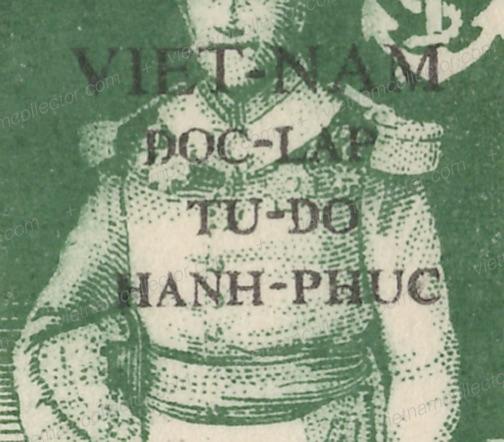
On field
 On fields D7,D10 and E7 one can find the error “H of HANH solid”
On fields D7,D10 and E7 one can find the error “H of HANH solid”

On field C5 one can find the error “diagonal Line of N in VN damaged”.

A number of overprint plate errors do occur on the 10C value. On field C3 one can find a “broken D in DOC-LAP”.
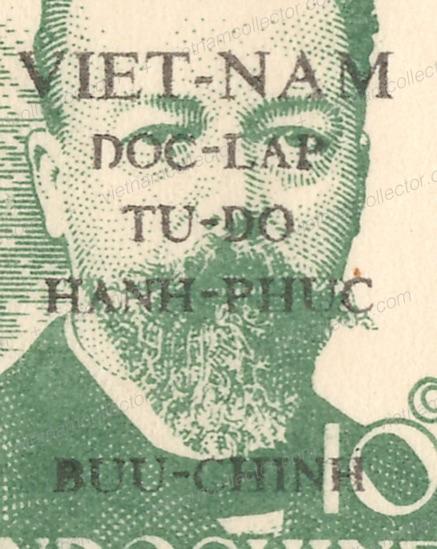
and on Field E8 one can find the overprint plate error of “E of VIET-NAM filled on top”.

However there are overprint characteristics that occur many times on each sheet, so would not qualify as overprint plate errors. Typical for that is the overprint that shows a filled H of HANH, a filled B of BUU and a partially filled H of CHINH. They are numerous and hence do not represent an error stamp.

Slanted overprint on the 20C value. Rare!
A number of overprint plat errors can be found on this stamp. On field A9 one can find the error “N of NV broken at top”.

On field C3 one can find the error “D of DOC broken”.

On field C6 one can find the error “H of HANH broken at bottom left”.

On field D9 one can find the error “black dot in C of PHUC”.

On field E1 one can find the error “C in PHUC solid”.
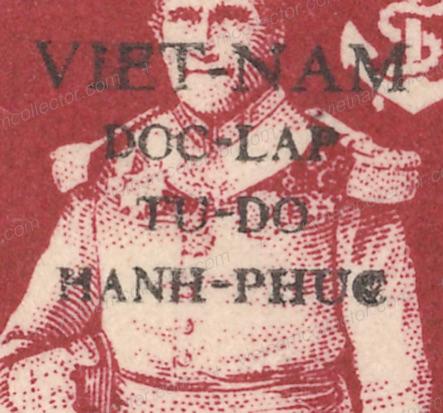
Cancelled to order pair of the 40C stamp showing the plate error of “white spot in hat” on the base stamp on the left side (Field C1).

Detailed scan of the affected area.

There is also an overprint error on field D10 which shoes a damaged C and O in CONG”.

This stamp shows the overprint error “D of DOC solid, B of BUU solid on top, C of CHINH looks like O and second H of CHINH solid at top.
Postal volume right after the war was still very limited. As a result these stamps did not see much commercial use and letters are very rare. Most items you will find are philatelic letters that are simply favor cancelled and mostly do not reflect the correct postal rates in force at the time. Below is a commercial letter sent registered by an insurance company ”Franco-Americaine D’Assurances” (on reverse). The proper rate for a standard letter at the time was 30c and the surcharge for registration was 60c. This letter carries a total postage of $1.26 as the envelope was larger and heavier than a standard envelope which afforded extra postage. The high nominal value such as the $1 (or 1 Piastre) nominal are extremely hard to find on postally used mail.
Letter fragment franked with three 10C overprinted stamps making up the standard letter rate. Cancelled in Tourane (Da Nang) on December 15th, 1946. BPM 418 of the Hue Annexe from January 12th, 1947 on the reverse.
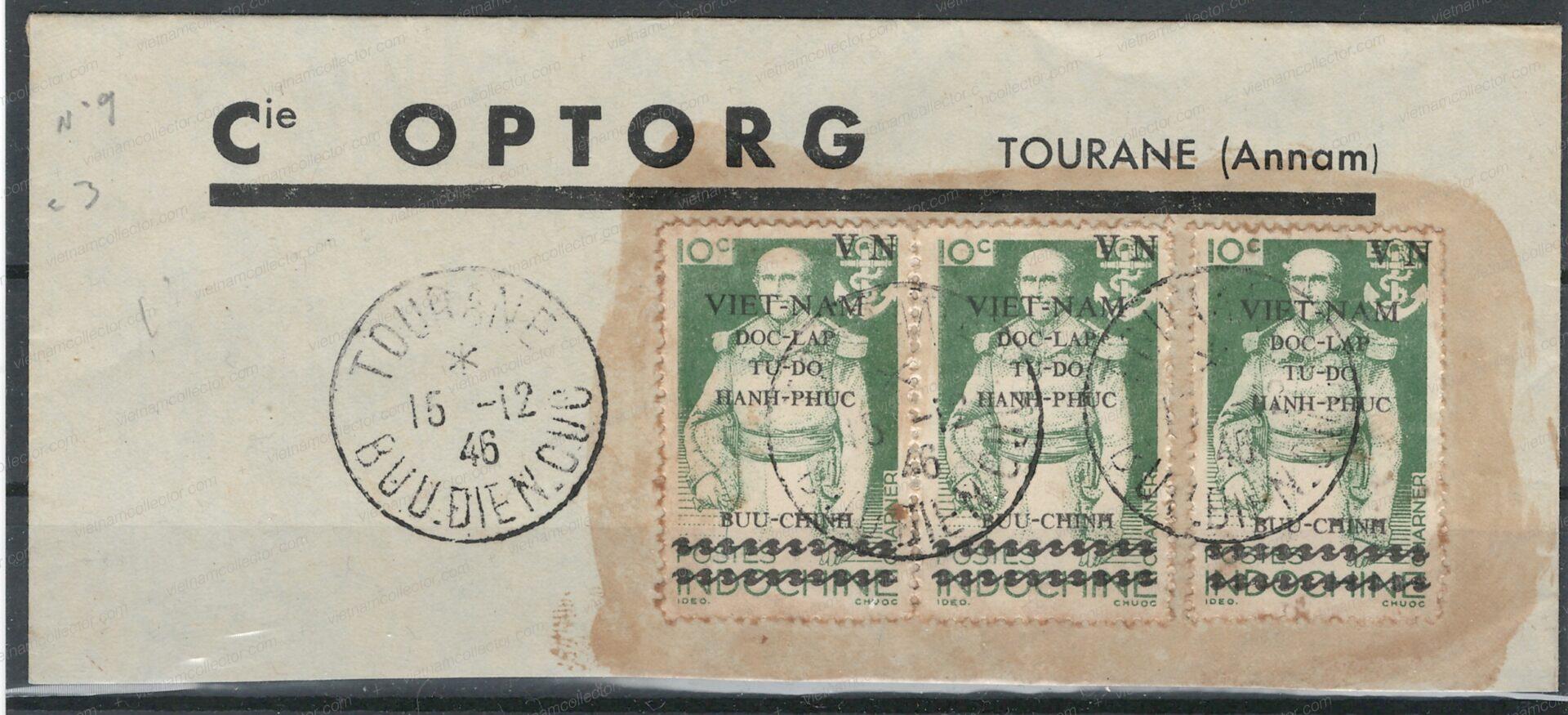
Here is a letter mailed locally in Hanoi via registered mail. The letter is franked with a block of four of the 10 Centime Charner plus the rare 1 Piaster overprints. The required rate for a 20g registered letter amounted to 90 Centimes so this letter may be over-franked or was heavier than the standard.
Registered letter mailed within Hanoi in February of 1946 featuring a block of four of the 20C value plus a pair of the 5C value for an overall postage of 90C. 90 cents was the correct postage for a registered 20g letter at the time.
Registered letter sent by the Office of Marine Travel in Hanoi locally In March of 1946. The letter carries a hand stamp in Vietnamese that states “franked by sender” which may help to explain that the postage was 10 Centimes higher than the required postage of 90 Centimes.

Registered letter sent in February of 1946 within Hanoi featuring a block of four of the 40C value paying an overall postage of 1.60 Piastres. The required rate was only 90C so this letter was probably philatelically inspired. The black hand stamp at the bottom means “Franked by the sender”. Ex Schwirtz.
Registered letter from the same correspondence but this time paying the correct tariff go 90 Centimes. Again, the black hand stamp at the bottom means “Franked by the sender”.

Philatelic letter prepared by “Maison Vietnam Philatelique” using one of the 9 Hao HCM stamps along with some Viet Minh overprints. The letter was cancelled with the Hanoi Trung Uong Bac Bo canceller on November 8th, 1946.
This letter is questionable. It carries a typewritten remark on the back that states in French “These three stamps which were not issued by the French post because of the incident of March 9th, 1945”. This is a philatelic reference to the Japanese take over of Indochina on that date. The original Indochinese stamps were in fact issued by the French on January 14th (5c nominal) and February 1st of 1946 (20c nominal). However one stamp, the 15c value (not on the cover) was issued by the Japanese on March 10th of 1945, which is rather curious. The 3c nominal was never issued without overprint. The letter carries a total of 28c in postage which is 2c shy of the regular letter rate of 30c. Also, the arrival cancel on the reverse is identical to the departure cancel. So, this is most likely a philatelic product that did not travel through the mail.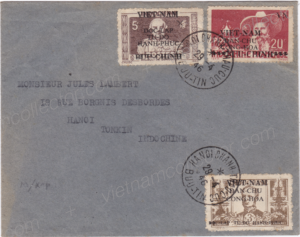
Cancelled specimens of these stamps are a lot less common than mint stamps due to their limited use. This is even true for stamps that were cancelled to order as the ones below. Michel values the smaller nominals up to 10c the same as mint and that is simply wrong. The higher values Michel VM Nr.9-12 are valued three times the value of the mint stamps but that multiple is still too low given their scarcity. Try to find a complete used set and you will see how long this will take you.
On the other hand, with a little patience one can occasionally find complete mint sheets of this issue on the market. Please note that the perforation varieties that are known on the original stamps also occur in the overprinted sheets. Some of these varieties are rather rare.
Note the reversed “Hanh Phuc” error on field F8 on the 2 c , 4c and 10c values:
[1] S.Tonnesson, Vietnam 1946, How the war began












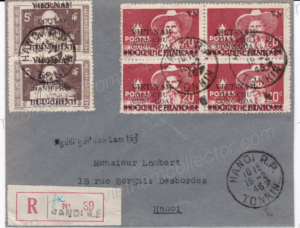










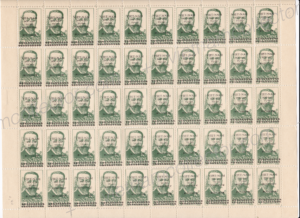




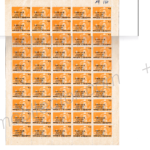



Comments are closed.